-


Y5 Science Fiction that is Out of this World!
£3.00 Add to basket £3.00Add to basket
£3.00Add to basketKS2 National Curriculum:
✓ Identifying features of fiction genres; discussing themes; building familiarity with narratives.
This lesson explores the settings, characters and plots of science fiction stories. Pupils use this information to design a poster showing the features of a science fiction story.
There is a five-minute evidence-based CPD activity at the end of this lesson which will develop classroom teachers’ skill set. This CPD consists of a research extract on metacognition with a five-minute activity based on this extract.
VIEW -


Y5 Home Sweet Dome
£3.00 Add to basket £3.00Add to basket
£3.00Add to basketKS2 National Curriculum:
✓ Describing settings; using expanded noun phrases and rich vocabulary.
This lesson looks at settings in a science fiction story in detail, and it includes answering higher and lower order questions on the settings of a science fiction story, reading extracts from science fiction stories and identifying the setting of these extracts.
There is a five-minute evidence-based CPD activity at the end of this lesson which will develop classroom teachers’ skill set. This CPD consists of a research extract on peer assessment with a five-minute activity based on this extract.
VIEW -


Y5 All Characters Welcome
£3.00 Add to basket £3.00Add to basket
£3.00Add to basketKS2 National Curriculum:
✓ Describing characters; developing dialogue and consistency in character.
Activities in this lesson include learning about the need to be consistent when describing a character; looking at the four conventional ways of describing a character, identifying the characteristics of good and bad characters in science fiction stories and answering higher and lower order questions.
There is a five-minute evidence-based CPD activity at the end of this lesson which will develop classroom teachers’ skill set. This CPD consists of a research extract on self-regulation with a five-minute activity based on this extract.
VIEW -


Y5 Robots Got Talent
£3.00 Add to basket £3.00Add to basket
£3.00Add to basketKS2 National Curriculum:
✓ Identifying structure and themes; participating in discussions and presentations.
Activities in this lesson include learning about common themes for science fiction stories, the structure of a science fiction story, the main features of science fiction stories, how to design a poster and creating a poster showing the key features of science fiction stories.
There is a five-minute evidence-based CPD activity at the end of this lesson which will develop classroom teachers’ skill set. This CPD consists of a research extract on peer assessment with a five-minute activity based on this extract.
VIEW -


Y5 A Galaxy of Grammar
£3.00 Add to basket £3.00Add to basket
£3.00Add to basketKS2 National Curriculum:
✓ Applying grammar: nouns, adjectives, pronouns, adjectival phrases, intensifiers.
Activities in this lesson include learning about and practising using nouns, synonyms, pronouns, adjectives, adjectival phrases and intensifiers in science fiction stories.
The five-minute evidence-based CPD activity at the end of this lesson offers teachers an opportunity to add to their skill set. The CPD activity in this lesson develops peer teaching by asking the question “how can I improve peer teaching?”
VIEW -
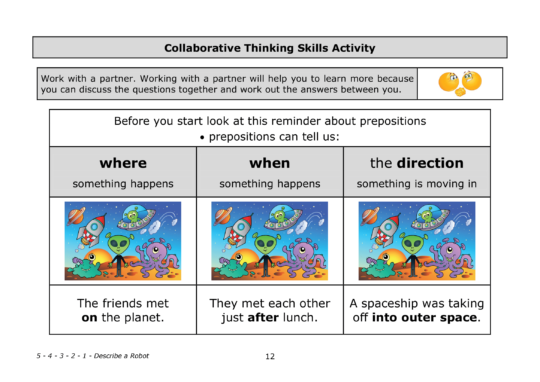

Y5 Describe a Robot
£3.00 Add to basket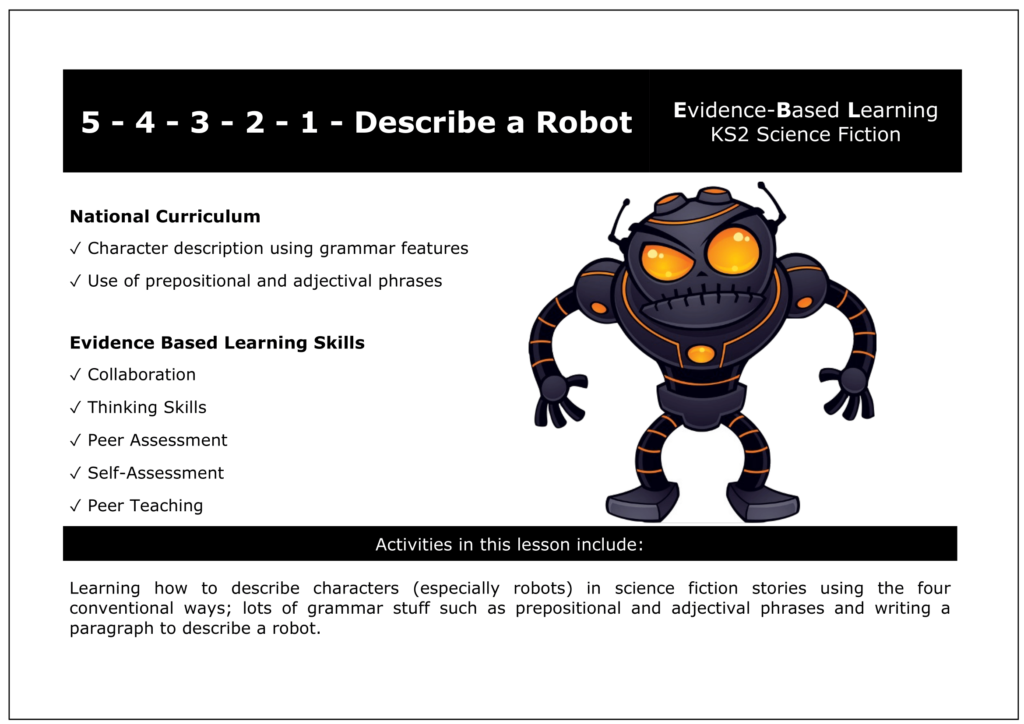 £3.00Add to basket
£3.00Add to basketKS2 National Curriculum:
✓ Character description using grammar features; use of prepositional and adjectival phrases.
Activities in this lesson include learning how to describe characters (especially robots) in science fiction stories using the four conventional ways; lots of grammar stuff such as prepositional and adjectival phrases and writing a paragraph to describe a robot.
The five-minute evidence-based CPD activity at the end of this lesson offers teachers an opportunity to add to their skill set. The CPD activity in this lesson develops peer teaching by asking the question “what are the benefits of peer teaching?”
VIEW -
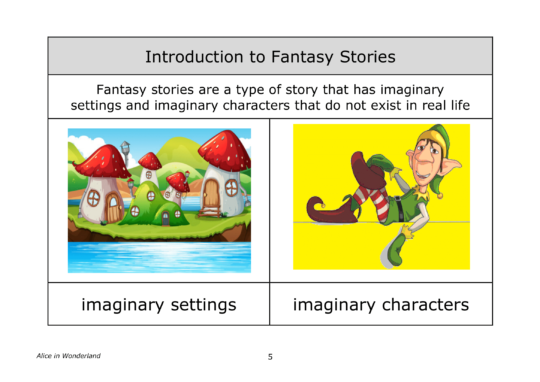

Y5 Alice in Wonderland
£3.00 Add to basket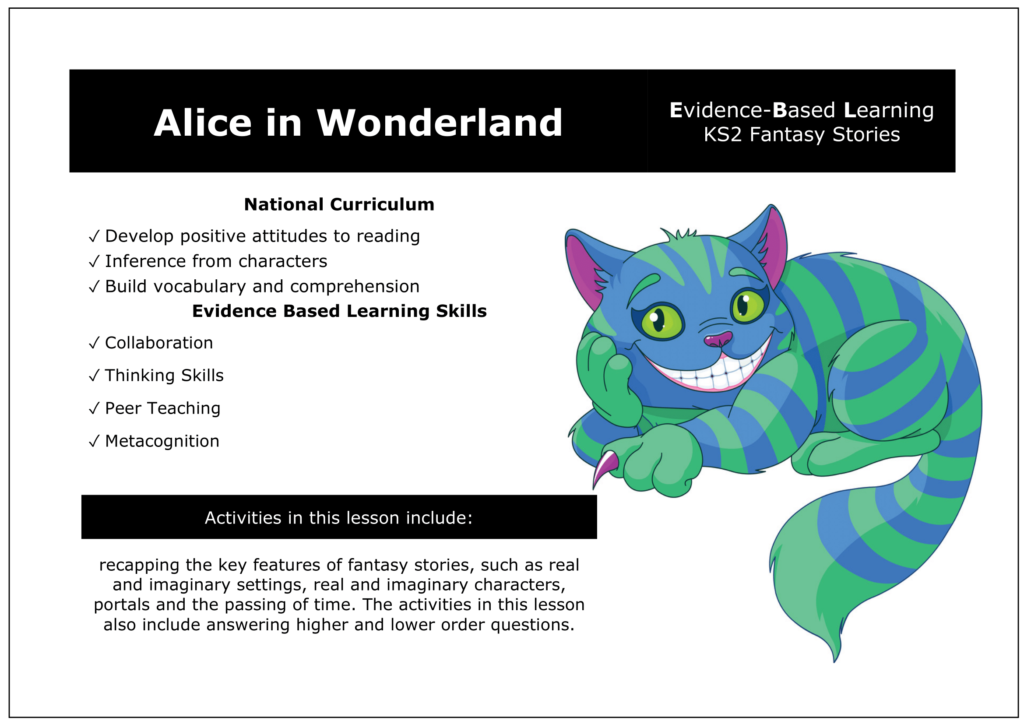 £3.00Add to basket
£3.00Add to basketKS2 National Curriculum:
✓ Develop positive attitudes to reading
✓ Inference from characters
✓ Build vocabulary and comprehensionActivities in this lesson include recapping the key features of fantasy stories, such as real and imaginary settings, real and imaginary characters, portals and the passing of time. The activities in this lesson also include answering higher and lower order questions.
There is a five-minute evidence-based CPD activity at the end of this lesson which will develop classroom teachers’ skill set. This CPD consists of a research extract on peer teaching with a five-minute activity based on this extract.
VIEW -


Y5 Alice, the White Rabbit and the Portal
£3.00 Add to basket £3.00Add to basket
£3.00Add to basketKS2 National Curriculum:
✓ Identify themes and conventions
✓ Understand story structure
✓ Develop speaking and listening through partner workActivities in this lesson include exploring the key components of fantasy stories: real and imaginary settings, real and imaginary characters, good vs evil, real journeys vs portals, the passing of time and the use of magic. Activities also include answering higher and lower order questions.
There is a five-minute evidence-based CPD activity at the end of this lesson which will develop classroom teachers’ skill set. This CPD consists of a research extract on collaboration with a five-minute activity based on this extract.
VIEW -


Y5 Rabbit Holes and Wardrobes
£3.00 Add to basket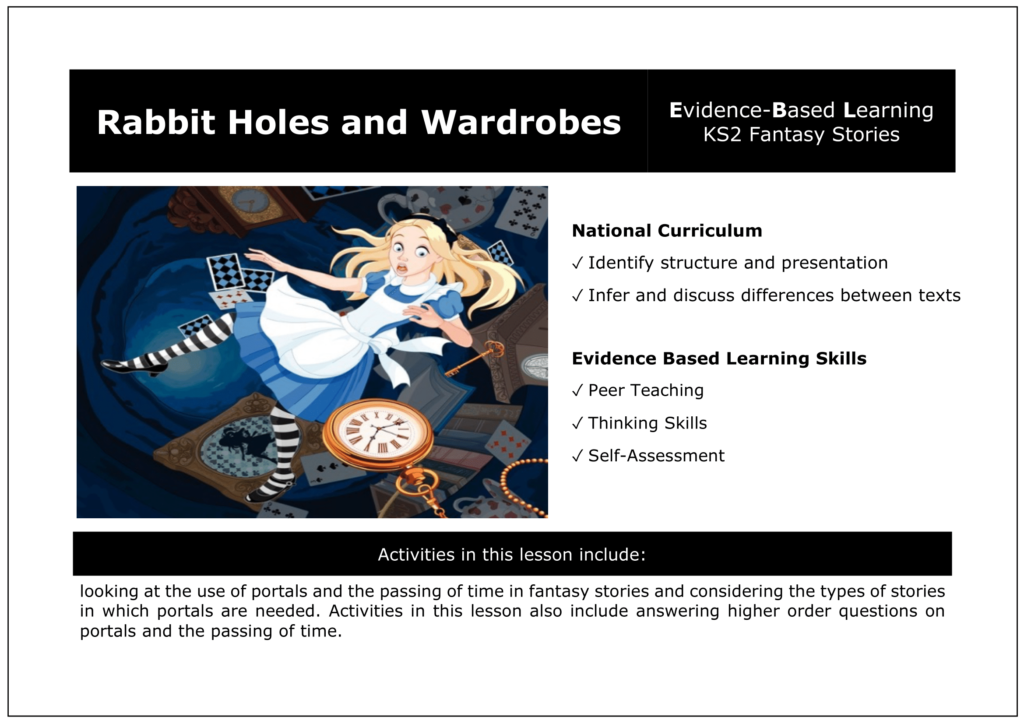 £3.00Add to basket
£3.00Add to basketKS2 National Curriculum:
✓ Identify structure and presentation
✓ Infer and discuss differences between textsActivities in this lesson include looking at the use of portals and the passing of time in fantasy stories and considering the types of stories in which portals are needed. Activities in this lesson also include answering higher order questions on portals and the passing of time.
There is a five-minute evidence-based CPD activity at the end of this lesson which will develop classroom teachers’ skill set. This CPD consists of a research extract on self-assessment with a five-minute activity based on this extract.
VIEW -
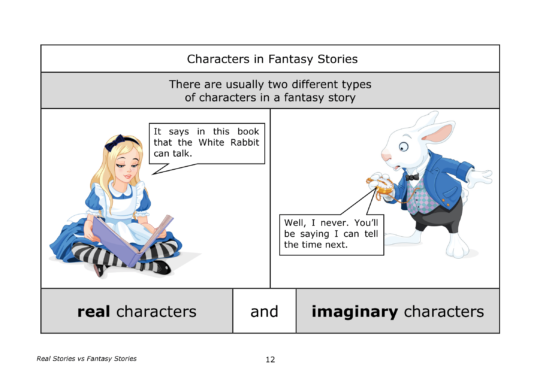

Y5 Real Stories vs Fantasy Stories
£3.00 Add to basket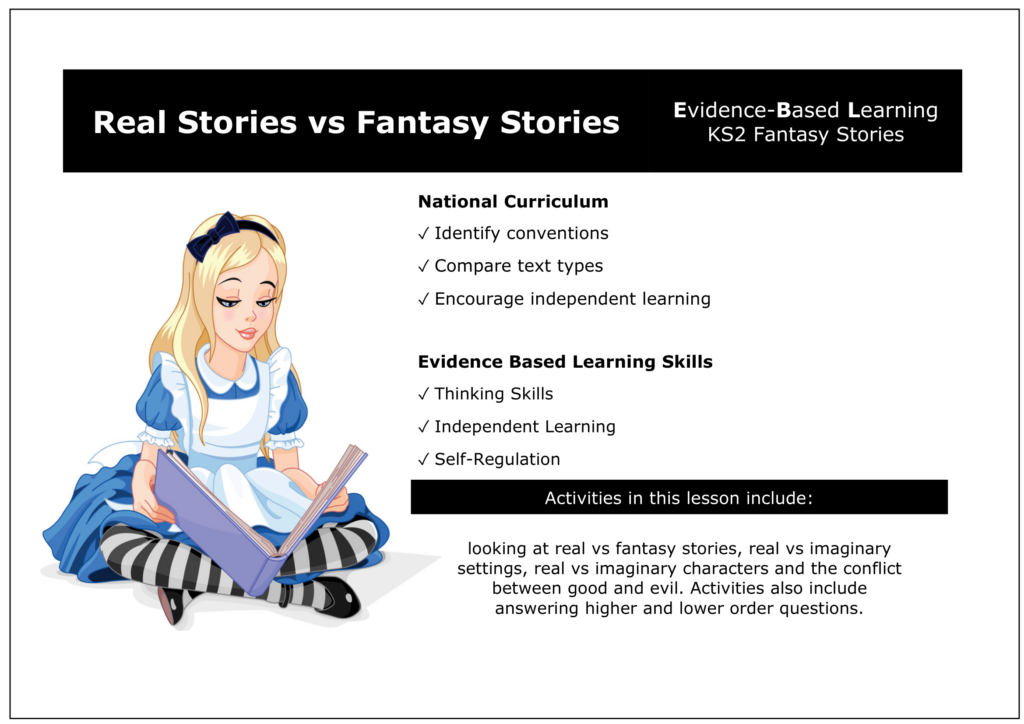 £3.00Add to basket
£3.00Add to basketKS2 National Curriculum:
✓ Identify conventions
✓ Compare text types
✓ Encourage independent learningActivities in this lesson include looking at real vs fantasy stories, real vs imaginary settings, real vs imaginary characters and the conflict between good and evil. Activities include answering higher and lower order questions.
There is a five-minute evidence-based CPD activity at the end of this lesson which will develop classroom teachers’ skill set. This CPD consists of a research extract on thinking skills with a five-minute activity based on this extract.
VIEW -

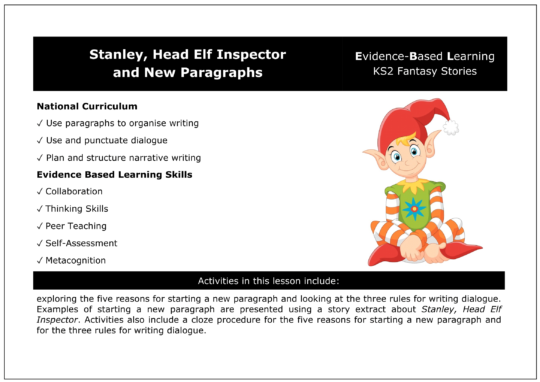
Y5 Stanley, Head Elf Inspector and New Paragraphs
£3.00 Add to basket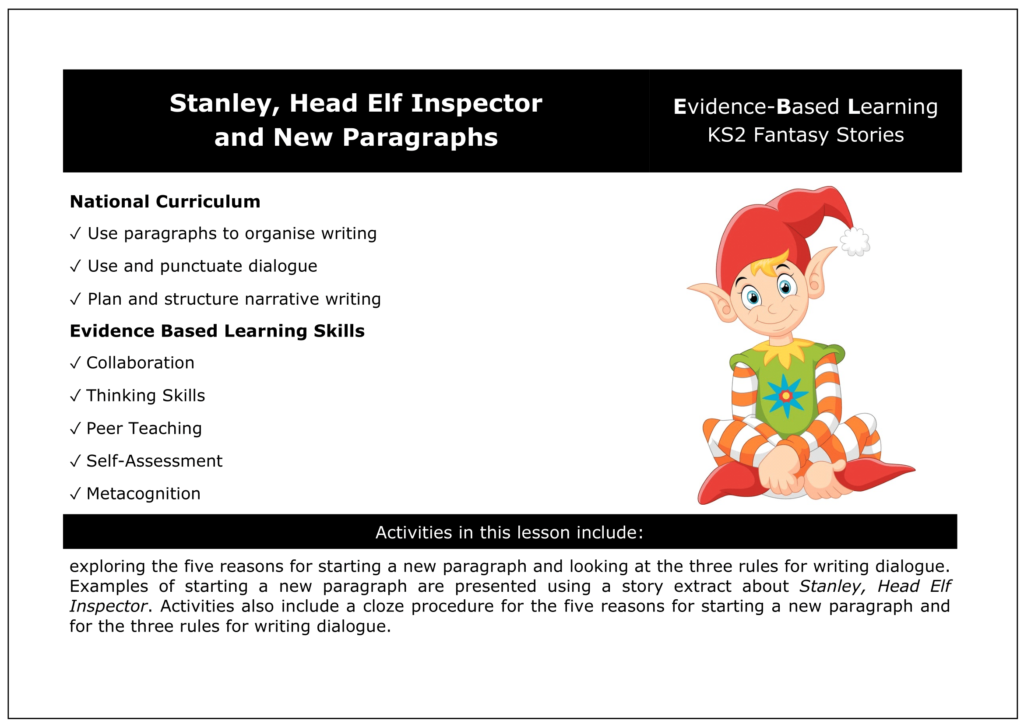 £3.00Add to basket
£3.00Add to basketKS2 National Curriculum:
✓ Use paragraphs to organise writing
✓ Use and punctuate dialogue
✓ Plan and structure narrative writingActivities in this lesson include exploring the five reasons for starting a new paragraph and looking at the three rules for writing dialogue. Examples of starting a new paragraph are presented using a story extract about Stanley, Head Elf Inspector. Activities also include a close procedure for the five reasons for starting a new paragraph and also for the three rules for writing dialogue.
There is a five-minute evidence-based CPD activity at the end of this lesson which will develop classroom teachers’ skill set. This CPD consists of a research extract on self-assessment with a five-minute activity based on this extract.
VIEW -


Y5 The Cook is really Long John Silver
£3.00 Add to basket £3.00Add to basket
£3.00Add to basketKS2 National Curriculum:
✓ Understanding bartering, currency, and trade in historical context
✓Explaining why treasure is buried and how maps are created
✓Completing a pirate plot story mountain
✓Exploring openings to pirate storiesThis lesson looks at why gold became so important and it introduces the concepts of bartering and trade. It also looks at why gold needed to be buried and considers the key role played by treasure maps in the plots of pirate stories. It also looks at the need to include good and bad characters. Activities include completing a story mountain outlining a possible plot for a pirate story and a task based on pirate story openings.
There is a five-minute evidence-based CPD activity at the end of this lesson which will develop classroom teachers’ skill set. This CPD consists of a research extract on collaboration with a five-minute activity based on this extract.
VIEW -


Y5 Why Gold was Buried
£3.00 Add to basket £3.00Add to basket
£3.00Add to basketKS2 National Curriculum:
✓ Understanding bartering, currency, and trade in historical context
✓Explaining why treasure is buried and how maps are created
✓Completing a pirate plot story mountain
✓Exploring openings to pirate storiesThis lesson looks at why gold became so important and it introduces the concepts of bartering and trade. It also looks at why gold needed to be buried and considers the key role played by treasure maps in the plots of pirate stories. It also looks at the need to include good and bad characters. Activities include completing a story mountain outlining a possible plot for a pirate story and a task based on pirate story openings.
There is a five-minute evidence-based CPD activity at the end of this lesson which will develop classroom teachers’ skill set. This CPD consists of a research extract on collaboration with a five-minute activity based on this extract.
VIEW -


Y5 Writing a Pirate Recount
£3.00 Add to basket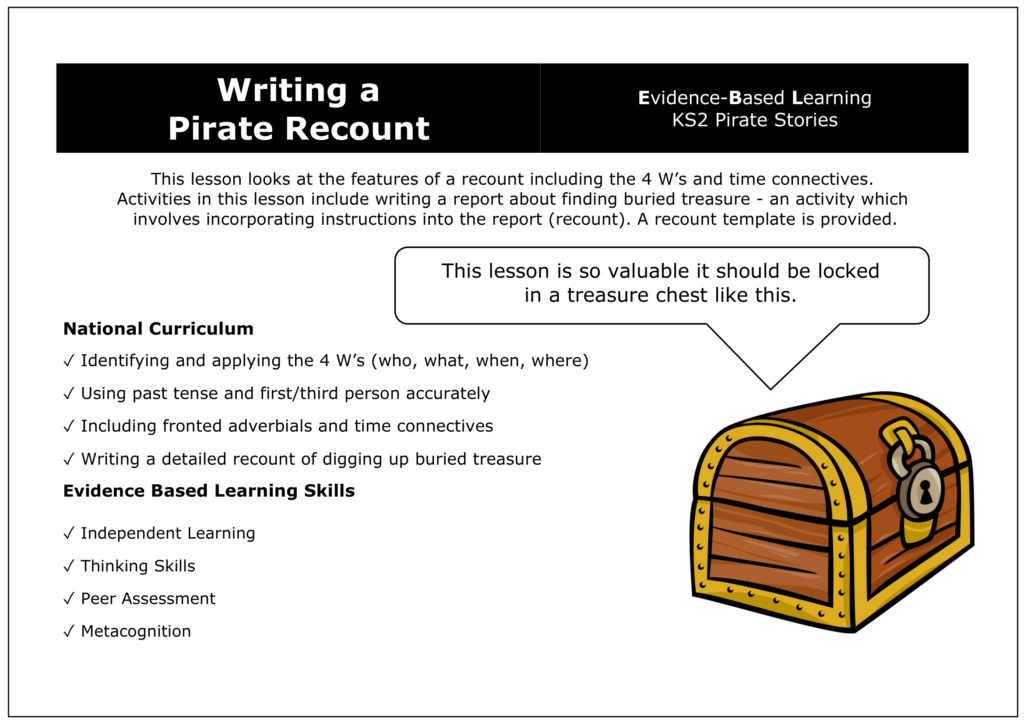 £3.00Add to basket
£3.00Add to basketKS2 National Curriculum:
✓ Identifying and applying the 4 W’s (who, what, when, where)
✓ Using past tense and first/third person accurately
✓ Including fronted adverbials and time connectives
✓ Writing a detailed recount of digging up buried treasureThis lesson looks at the features of a recount including the 4 W’s and time connectives. Activities in this lesson include writing a report about finding buried treasure – an activity which involves incorporating instructions into the recount. A recount template is provided.
There is a five-minute evidence-based CPD activity at the end of this lesson which will develop classroom teachers’ skill set. This CPD consists of a research extract on peer assessment with a five-minute activity based on this extract.
VIEW -
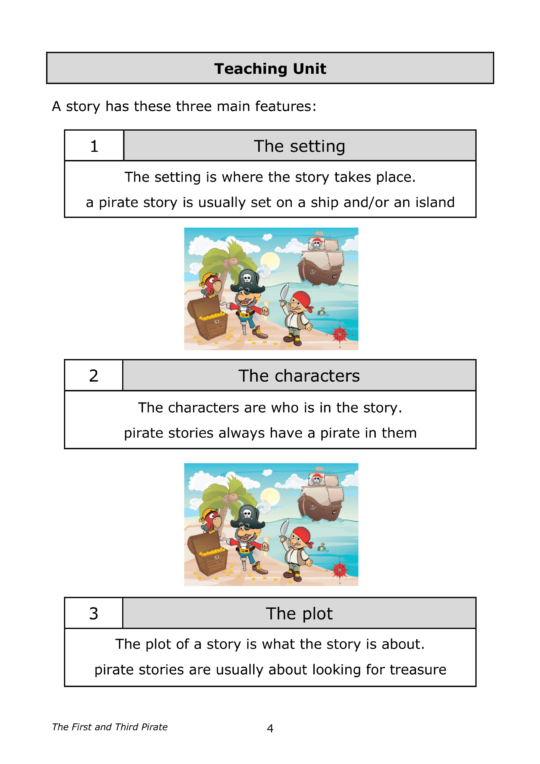

Y5 / Y6 The First and Third Pirate
£3.00 Add to basket £3.00Add to basket
£3.00Add to basketKS2 National Curriculum:
✓ Identifying first- and third-person narrative voices
✓ Understanding present, past, and future tenses
✓ Converting text from third person to first person
✓ Peer and self-assessment of written perspectiveThis lesson looks at person and tense through extracts from pirate stories. Activities include answering higher and lower order questions and a first/third person close activity.
There is a five-minute evidence-based CPD activity at the end of this lesson which will develop classroom teachers’ skill set. This CPD consists of a research extract on self-assessment with a five-minute activity based on this extract.
VIEW -


Y5 Cabin Boys and Cabin Girls
£3.00 Add to basket £3.00Add to basket
£3.00Add to basketKS2 National Curriculum:
✓ Describing characters consistently using four key lenses
✓ Developing contrasting character traits (friendly vs. nasty pirates)
✓ Creating a new cabin boy/girl character for a pirate storyThis lesson looks at how to describe a character in four different ways; by what they think or feel, what they say and how they say it, what they do or how they behave, and by what they look like. After looking at a nice pirate described in these four ways pupils have to describe a nasty pirate in the same four ways. Pupils also learn about cabin boys and girls before describing a cabin boy/girl of their own.
There is a five-minute evidence-based CPD activity at the end of this lesson which will develop classroom teachers’ skill set. This CPD consists of a research extract on peer assessment with a five-minute activity based on this extract.
VIEW -
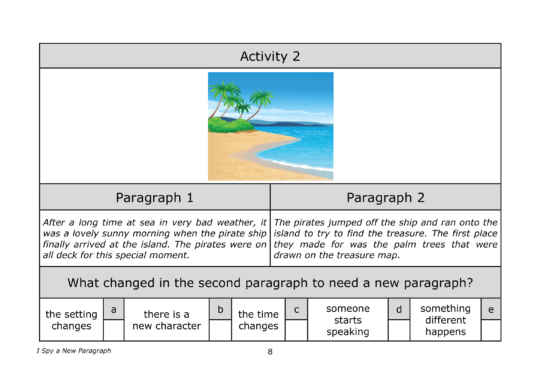

Y5 I Spy a New Paragraph
£0.00 Download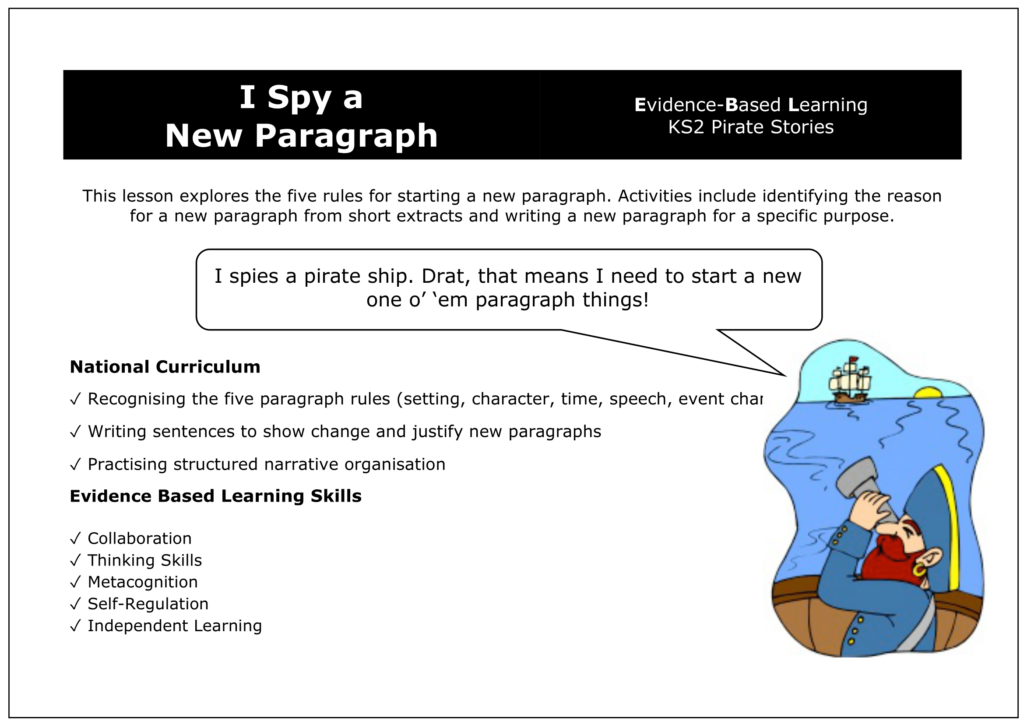 £0.00
£0.00KS2 National Curriculum:
✓ Recognising the five paragraph rules (setting, character, time, speech, event change)
✓ Writing sentences to show change and justify new paragraphs
✓ Practising structured narrative organisationThis lesson explores the five rules for starting a new paragraph. Activities include identifying the reason for a new paragraph from short extracts and writing a new paragraph for a specific purpose.
There is a five-minute evidence-based CPD activity at the end of this lesson which will develop classroom teachers’ skill set. This CPD consists of a research extract on self-regulation with a five-minute activity based on this extract.
(Downloads - 6)
VIEW -
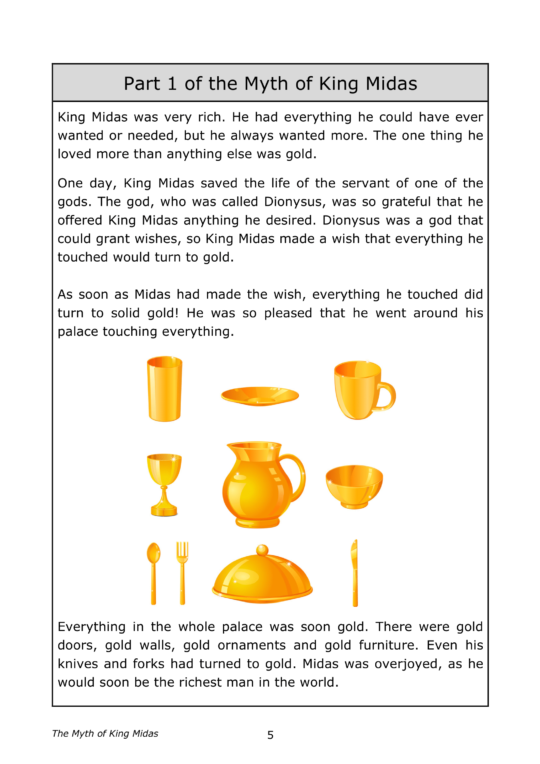
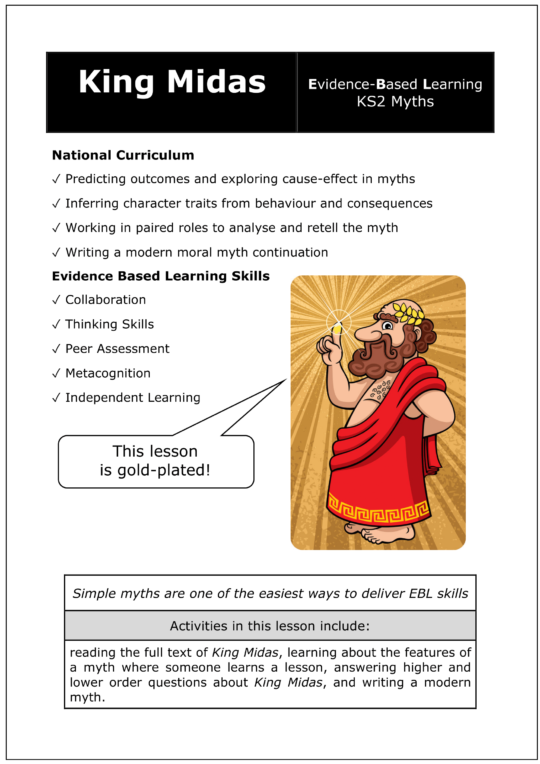
Y5 King Midas
£3.00 Add to basket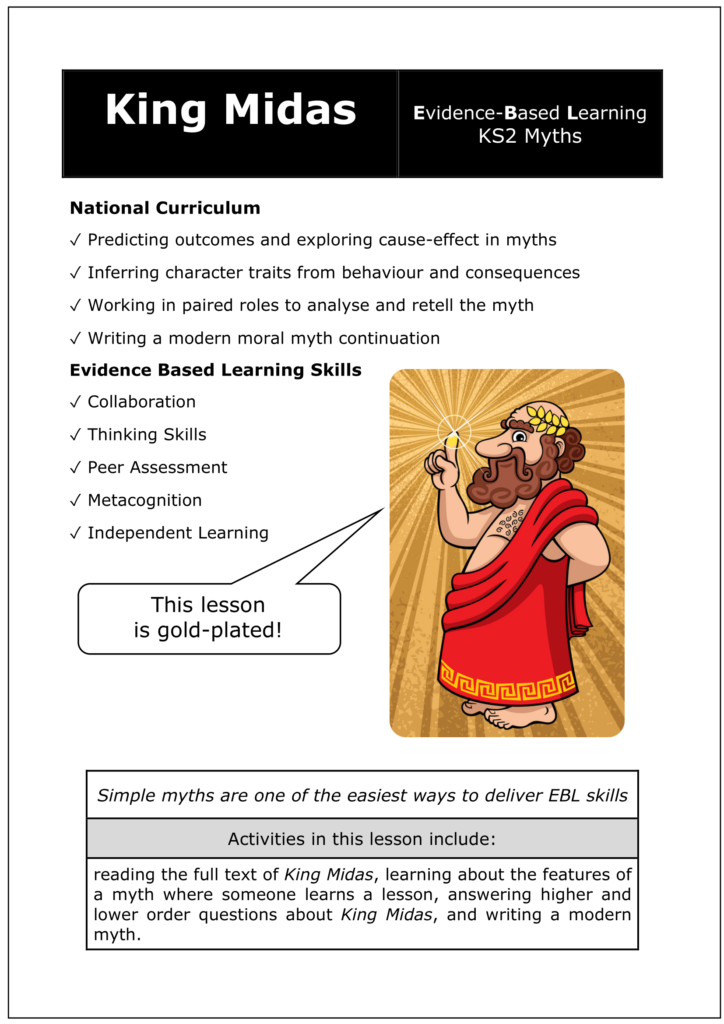 £3.00Add to basket
£3.00Add to basketKS2 National Curriculum:
✓ Predicting outcomes and exploring cause-effect in myths
✓ Inferring character traits from behaviour and consequences
✓ Working in paired roles to analyse and retell the myth
✓ Writing a modern moral myth continuationActivities in this lesson include reading the full text of King Midas, learning about the features of a myth where someone learns a lesson, answering higher and lower order questions about King Midas, writing a tweet and writing a modern myth.
There is a five-minute evidence-based CPD activity at the end of this lesson which will develop classroom teachers’ skill set. This CPD consists of a research extract on peer assessment with a five-minute activity based on this extract.
VIEW -
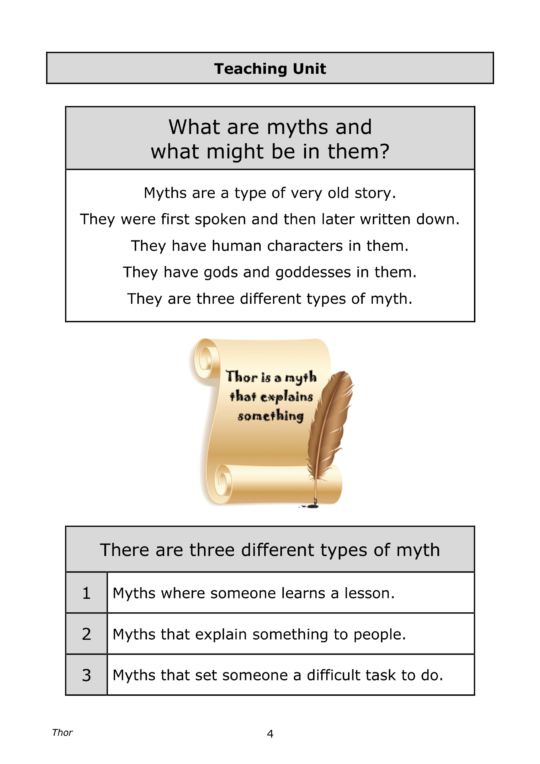
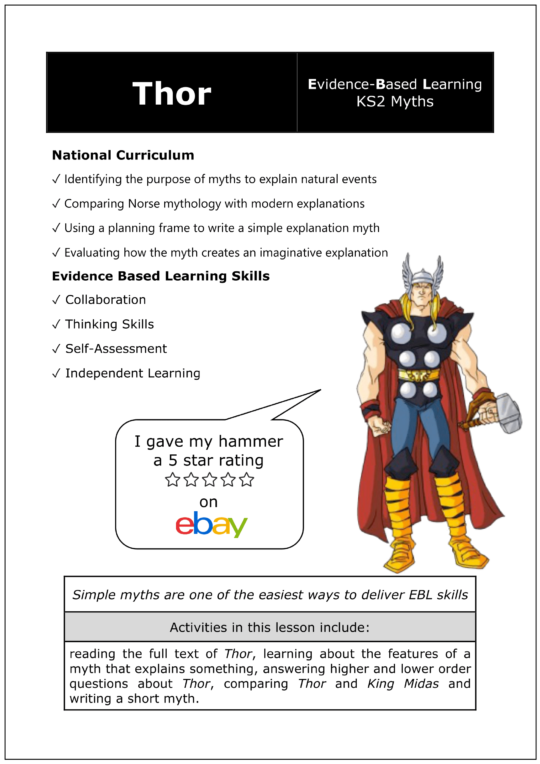
Y5 Thor
£3.00 Add to basket £3.00Add to basket
£3.00Add to basketKS2 National Curriculum:
✓ Identifying the purpose of myths to explain natural events
✓ Comparing Norse mythology with modern explanations
✓ Using a planning frame to write a simple explanation myth
✓ Evaluating how the myth creates an imaginative explanationActivities in this lesson include reading the full text of Thor, learning about the features of a myth that explains something, answering higher and lower order questions about Thor, comparing Thor and King Midas and writing a short myth.
There is a five-minute evidence-based CPD activity at the end of this lesson which will develop classroom teachers’ skill set. This CPD consists of a research extract on self-assessment with a five-minute activity based on this extract.
VIEW -
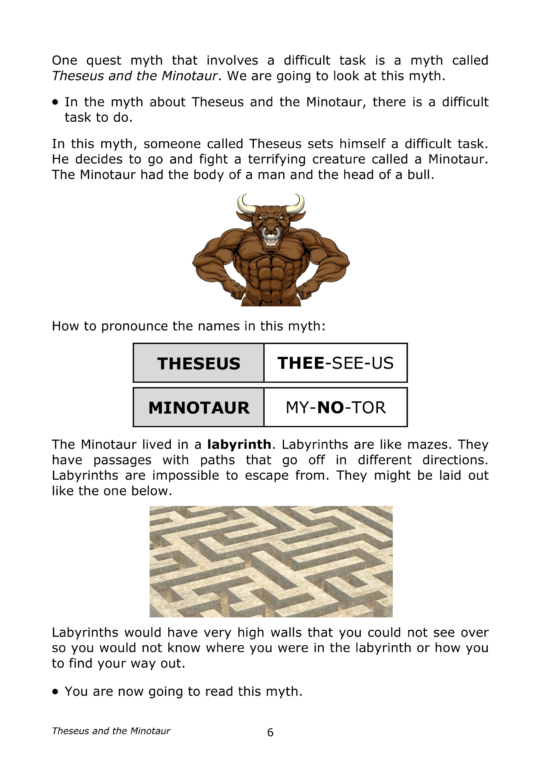
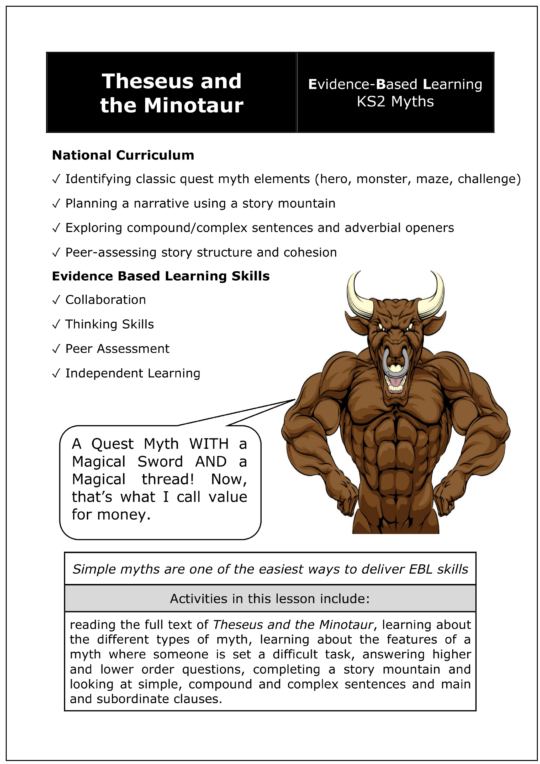
Y5 Theseus and the Minotaur
£3.00 Add to basket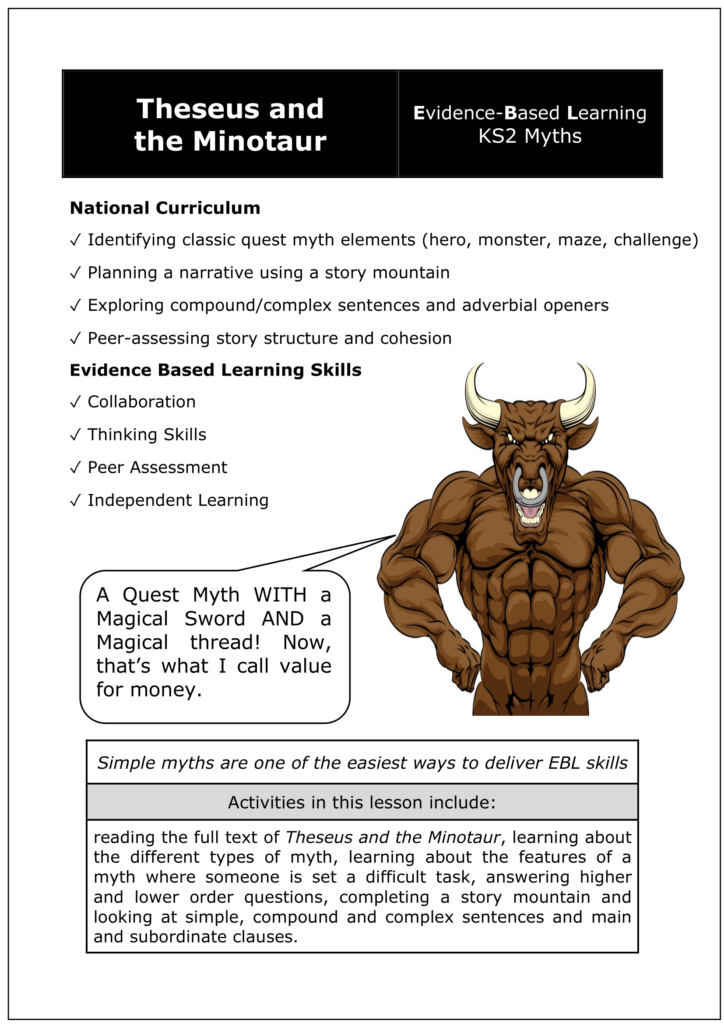 £3.00Add to basket
£3.00Add to basketKS2 National Curriculum:
✓ Identifying classic quest myth elements (hero, monster, maze, challenge)
✓ Planning a narrative using a story mountain
✓ Exploring compound/complex sentences and adverbial openers
✓ Peer-assessing story structure and cohesionActivities in this lesson include reading the full text of Theseus and the Minotaur, learning about the different types of myth, learning about the features of a myth where someone is set a difficult task, answering higher and lower order questions, completing a story mountain and looking at simple, compound and complex sentences and main and subordinate clauses.
There is a five-minute evidence-based CPD activity at the end of this lesson which will develop classroom teachers’ skill set. This CPD consists of a research extract on collaboration with a five-minute activity based on this extract.
VIEW -


Y5 Learning About Legends
£3.00 Add to basket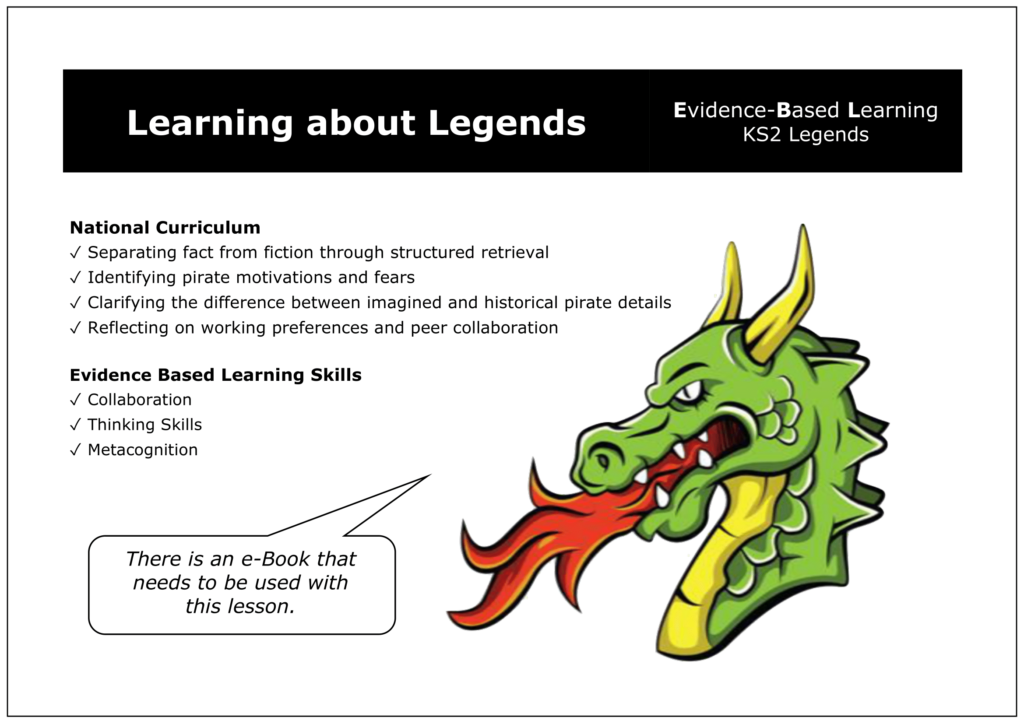 £3.00Add to basket
£3.00Add to basketKS2 National Curriculum:
✓ Identifying traits of legendary characters and their actions
✓ Exploring story elements such as setting, heroism, exaggeration, and moral impact
✓ Completing collaborative tasks using a shared text
✓ Presenting findings based on evidence from the eBook
Activities in this lesson include learning about the features of legends, looking at St. George and the Dragon and Robin Hood and looking at how legends are structured so that the following questions can be answered; ‘What are legends about? When were legends written? What type of characters are in legends? Are legends true?’
There is a five-minute evidence-based CPD activity at the end of this lesson which will develop classroom teachers’ skill set. This CPD consists of a research extract on collaboration with a five-minute activity based on this extract.
VIEW -

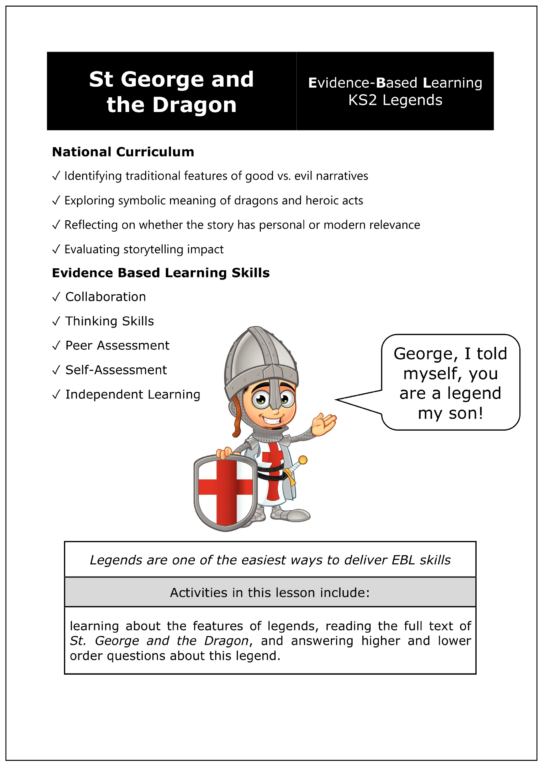
Y5 St George and the Dragon
£3.00 Add to basket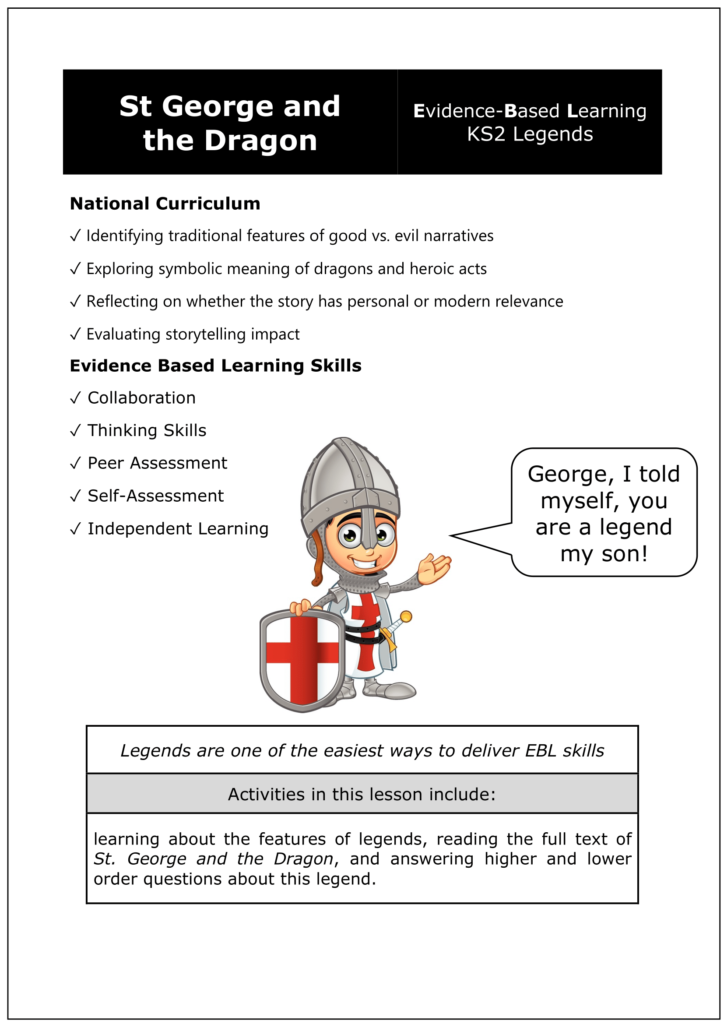 £3.00Add to basket
£3.00Add to basketKS2 National Curriculum:
✓ Identifying traditional features of good vs. evil narratives
✓ Exploring symbolic meaning of dragons and heroic acts
✓ Reflecting on whether the story has personal or modern relevance
✓ Evaluating storytelling impactActivities in this lesson include learning about the features of legends, reading the full text of St. George and the Dragon, and answering higher and lower order questions about this legend.
There is a five-minute evidence-based CPD activity at the end of this lesson which will develop classroom teachers’ skill set. This CPD consists of a research extract on peer assessment with a five-minute activity based on this extract.
VIEW -


Introduction to Fables
£3.00 Add to basket £3.00Add to basket
£3.00Add to basketKS2 National Curriculum:
✓ Identifying characters, setting, and moral structure in fables
✓ Understanding the role of animal characters and human traits
✓ Summarising and explaining key features using a visual guide
✓ Reflecting on the purpose of fables in teaching lessonsActivities in this lesson include learning about the features of fables, answering higher and lower order questions about fables and writing a tweet explaining what a fable is.
There is a five-minute evidence-based CPD activity at the end of this lesson which will develop classroom teachers’ skill set. This CPD consists of a research extract on metacognition with a five-minute activity based on this extract.
VIEW -


Y5 The Fox and the Goat
£3.00 Add to basket £3.00Add to basket
£3.00Add to basketKS2 National Curriculum:
✓ Reading and sequencing key events
✓ Exploring vocabulary (e.g. “gullible”)
✓ Creating tweet-length summaries and short writing responses
✓ Analysing decision-making and moral consequencesActivities in this lesson include learning about the features of fables including their purpose, reading the full text of Aesop’s famous fable The Fox and the Goat, answering higher and lower order questions about this fable, arranging the events in the fable in chronological order, writing a tweet that the goat might write about not getting tricked by crafty foxes even if you are really thirsty!
There is a five-minute evidence-based CPD activity at the end of this lesson which will develop classroom teachers’ skill set. This CPD consists of a research extract on self-regulation with a five-minute activity based on this extract.
VIEW -


Y5 Looking at the Features of Fables
£3.00 Add to basket £3.00Add to basket
£3.00Add to basketKS2 National Curriculum:
✓ Recognising common structural elements of fables
✓ Exploring animals as character types and moral messengers
✓ Writing a leaflet explaining fable features
✓ Analysing how language conveys a warning messageActivities in this lesson include learning about the features of fables including their purpose in detail, answering higher and lower order questions on the features of fables, reading the text of The Fox and the Crow, designing a leaflet warning all other animals to beware of the crafty fox and completing a true/false exercise that includes all the features of a fable.
There is a five-minute evidence-based CPD activity at the end of this lesson which will develop classroom teachers’ skill set. This CPD consists of a research extract on self-assessment with a five-minute activity based on this extract.
VIEW -


Y5 & Y6 The Fox and the Crow
£3.00 Add to basket £3.00Add to basket
£3.00Add to basketKS2 National Curriculum:
✓ Interpreting characters’ motives and lessons
✓ Explaining the warning within a fable
✓ Writing a five-sentence original fable using model features
✓ Peer assessing for structure and moral clarityActivities in this lesson include reminders about the main features of fables, reading the full text of The Fox and the Crow, answering higher and lower order questions about the fable, looking at the moral in a fable and breaking down The Fox and the Crow into five sentences.
There is a five-minute evidence-based CPD activity at the end of this lesson which will develop classroom teachers’ skill set. This CPD consists of a research extract on collaboration with a five-minute activity based on this extract.
VIEW -


Y5 Nailing a Setting
£3.00 Add to basket £3.00Add to basket
£3.00Add to basketKS2 National Curriculum:
✓ Identifying setting components: place, time of day, time period, and weather
✓ Analysing visual cues and using setting vocabulary
✓ Teaching peers to consolidate understanding
✓ Generating original examples through partner workThis lesson looks at the four possible features of a story setting: the place, the time period, the time of day and the weather. It also looks at real and imaginary settings. Activities include answering higher and lower order questions.
There is a five-minute evidence-based CPD activity at the end of this lesson which will develop classroom teachers’ skill set. This CPD consists of a research extract on peer teaching with a five-minute activity based on this extract.
VIEW -


Y5 It’s Midnight and it’s Raining
£3.00 Add to basket £3.00Add to basket
£3.00Add to basketKS2 National Curriculum:
✓ Using clues to infer time, place, and genre
✓ Sorting settings into real and imagined categories
✓ Predicting genre from setting detail
✓ Peer discussion with justificationThis lesson focuses on the four key features of a story setting:
- the place where the story is set
- the time that the story is set
- the time of day
- the weather
Activities include answering higher and lower order questions.
There is a five-minute evidence-based CPD activity at the end of this lesson which will develop classroom teachers’ skill set. This CPD consists of a research extract on metacognition with a five-minute activity based on this extract.
VIEW -


Y5 Super Settings
£3.00 Add to basket £3.00Add to basket
£3.00Add to basketKS2 National Curriculum:
✓ Comparing fantasy, sci-fi, pirate, and traditional settings
✓ Spotting patterns in descriptive language and story type
✓ Explaining how settings influence tone and events
✓ Writing comparative statements and reflectionsThis lesson explores why different types of stories have different settings and it compares real and imaginary settings. Activities include answering higher and lower order questions.
There is a five-minute evidence-based CPD activity at the end of this lesson which will develop classroom teachers’ skill set. This CPD consists of a research extract on peer teaching with a five-minute activity based on this extract.
VIEW -


Y5 Shifting Settings
£3.00 Add to basket £3.00Add to basket
£3.00Add to basketKS2 National Curriculum:
✓ Exploring narrative changes in location, time, and mood
✓ Writing connected events showing setting shifts
✓ Using cohesive devices to link paragraphs
✓ Peer evaluation using success criteriaThis lesson looks in detail at the four main reasons why the setting in a story can change: the action in the story moves to a different setting, the characters in the story move to a different setting, the setting stays the same but the time of day changes and the setting stays the same but the weather changes. Activities include answering higher and lower order questions.
There is a five-minute evidence-based CPD activity at the end of this lesson which will develop classroom teachers’ skill set. This CPD consists of a research extract on self-assessment with a five-minute activity based on this extract.
VIEW -

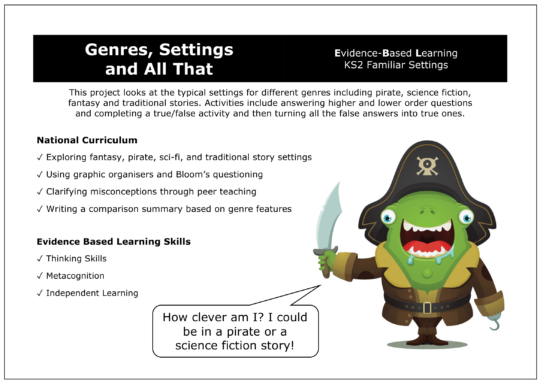
Y5 / Y6 Genres, Settings and All That (project)
£3.00 Add to basket £3.00Add to basket
£3.00Add to basketKS2 National Curriculum:
✓ Exploring fantasy, pirate, sci-fi, and traditional story settings
✓ Using graphic organisers and Bloom’s questioning
✓ Clarifying misconceptions through peer teaching
✓ Writing a comparison summary based on genre featuresThis project looks at the typical settings for different genres including pirate, science fiction, fantasy and traditional stories. Activities include answering higher and lower order questions and completing a true/false activity and then turning all the false answers into true ones.
There is a five-minute evidence-based CPD activity at the end of this lesson which will develop classroom teachers’ skill set. This CPD consists of a research extract on independent learning with a five-minute activity based on this extract.
VIEW -


Y5 The Golden Age of Piracy
£3.00 Add to basket £3.00Add to basket
£3.00Add to basketKS2 National Curriculum:
✓ Understanding historical facts about galleons, trade, and global routes
✓ Clarifying the setting and context of pirate stories
✓ Extracting information from non-fiction texts
✓ Collaborating with a partner to share and consolidate learning
This lesson introduces the Golden Age of piracy and looks at the use of galleons in the silk trade with China and the spice trade with India. The types of goods that pirates might steal are considered. This lesson also looks at what pirates ate and drank on-board. The activities in this lesson include answering higher and lower order questions and considering whether real pirates had peg legs and eye patches!
There is a five-minute evidence-based CPD activity at the end of this lesson which will develop classroom teachers’ skill set. This CPD consists of a research extract on collaboration with a five-minute activity based on this extract.
VIEW -


Y5 Introduction to Real Pirates
£3.00 Add to basket £3.00Add to basket
£3.00Add to basketKS2 National Curriculum:
✓ Separating fact from fiction through structured retrieval
✓ Identifying pirate motivations and fears
✓ Clarifying the difference between imagined and historical pirate details
✓ Reflecting on working preferences and peer collaborationThis lesson continues with the theme of the Golden Age of piracy and looks at the main aspects of the pirate life, such as how dangerous it was and how pirates came to be ‘pirates’ in the first place. Other aspects include why parrots were ideal pets for pirates, what pirates wore, the pirate code and the pirate flag. The activities in this lesson include answering higher and lower order questions.
There is a five-minute evidence-based CPD activity at the end of this lesson which will develop classroom teachers’ skill set. This CPD consists of a research extract on collaboration with a five-minute activity based on this extract.
VIEW -


Y5 Looking at a Character in Treasure Island
£3.00 Add to basket £3.00Add to basket
£3.00Add to basketKS2 National Curriculum:
✓ Identifying character traits through description
✓ Using evidence from the text
✓ Descriptive writing continuation in the character’s voice
Activities include answering higher and lower order questions based on an extract from the book and writing a new paragraph for Treasure Island.
There is a five-minute evidence-based CPD activity at the end of this lesson which will develop classroom teachers’ skill set. This CPD consists of a research extract on metacognition with a five-minute activity based on this extract.
VIEW -


Y5 & Y6 Looking at Dialogue in Treasure Island
£3.00 Add to basket £3.00Add to basket
£3.00Add to basketKS2 National Curriculum:
✓ Recognising the purpose of dialogue in storytelling
✓ Modernising dialogue
✓ Planning and writing a story opening with a stolen mapThis lesson looks at the role of dialogue using an extract from Treasure Island and how to punctuate dialogue. Activities include answering higher and lower order questions as well as writing the opening paragraph of a pirate story after considering three alternative ways of opening the story.
There is a five-minute evidence-based CPD activity at the end of this lesson which will develop classroom teachers’ skill set. This CPD consists of a research extract on collaboration with a five-minute activity based on this extract.
VIEW
